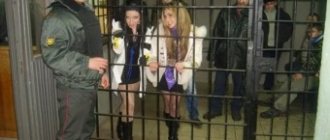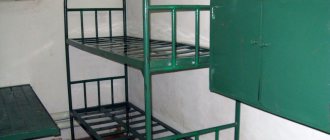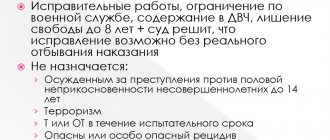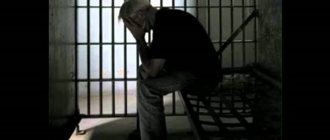Definition
How does ShIZO stand for? This abbreviation should be understood as a punishment cell or a special prison department in which cells for special prisoners are located.
The main difference between such “compartments” are:
- Extremely small sizes - no more than 9 square meters;
- Lack of warm water contributes to the flourishing of lice and skin diseases;
- Lack of light - to illuminate the space they use a light bulb of the lowest power. As a rule, it is installed either on the ceiling or in a niche above the door and protected with a mesh;
- Lack of windows - there may be only one small window in the cell, but it is also closed with a piece of wood or iron;
- Folding bunks - raised for the day and lowered for the night. But the main problem is that if there are a large number of violators in one room, there are not enough bunks for everyone, so at night the prisoners often take turns sleeping. Sitting and lying on bunks or the floor during the daytime is strictly prohibited;
- Lack of normal chairs and tables - the dimensions of the tables installed in most isolation wards are 20 x 30 cm. The role of chairs is played by so-called “mushrooms”, reminiscent of half a child’s stool;
- Dampness and low temperature are explained by concrete walls and floors. During the cold season, the temperature in the punishment cell rarely exceeds 10-15 degrees;
- Lack of ventilation and a proper toilet - the latter is located right in the cell and most often does not work, so there is a constant unpleasant smell in the room;
- Poor nutrition.
In addition, a prisoner staying in a punishment cell does not have the right to:
- Receive parcels;
- Store personal belongings;
- Convey letters and oral messages;
- Meet with any of the visitors;
- Enter into marriages;
- Submit complaints and statements;
- Read books (except textbooks);
- To listen to the radio;
- Talking on the phone;
- Order food from the YiW store.
It should also be noted that if the offender is studying at a school or university, he cannot leave the cell for the sake of studying, but has the right to demand notes and textbooks to independently familiarize himself with the material.
Permitted activities include hour-long walks, conversations with a clergyman, as well as hygiene procedures and storage of the products necessary for their implementation.
What is the difference between a punishment cell and a punishment cell? The main difference between these punishments is the quality of food and the complete lack of communication with the outside world.
Complete social isolation
Solitary confinement is considered as a place of detention for a prisoner only in exceptional cases. According to Article 131 of the Penal Code of the Russian Federation, solitary punishment is typical only for prisons. There are only two prisons with such cells in the Russian Federation. A person doomed to be alone can see his relatives only twice a year on short-term visits. Money from the personal account of the punished person is not spent; in the cell it is allowed to have a standard set for personal hygiene, religious literature and the latest newspapers issued to prisoners.
Why are they put in a punishment cell?
Why are they put in a punishment cell in a colony? The legislation specifies 2 main reasons why a prisoner can be sent to a punishment cell.
These include:
- Repeated violations of the detention regime - fights, constant scandals, non-compliance with internal regulations, failure to exercise, etc.;
- Possession of prohibited items found during a search of the cell.
But in reality, you can end up in a punishment cell for other offenses:
- Refusal to comply with illegal demands of a prisoner who is on good terms with the prison administration;
- Refusal to shovel snow instead of sleeping at night;
- Refusal to comply with illegal demands of the management of a correctional institution;
- Writing a complaint against prison employees;
- The requirement to provide the required clothing allowance and food products.
Placement in a punishment cell is an extreme measure of punishment applied to a prisoner. The decision on its expediency is made by the administration of the correctional institution.
Introduction to the special prison section
A punishment cell in a prison is a special place for punishment. As practice shows, some prisoners behind barbed wire easily accept forced confinement. To influence such prisoners, the prison administration has to resort to extreme measures and introduce the most severe form of punishment, namely, isolate and place the offender in a punishment cell.
Explanation of a punishment cell in prison means a punishment cell. According to experts, the severity of the punishment is further aggravated by the fact that the isolated prisoner loses the right to receive a visit and a parcel. Despite the decoding, in the punishment cell prison they are also called kandey.
Exceptions to the rules
According to the legislation in force in Russia in 2021 (Article 117 of the Criminal Executive Code), the following cannot be placed in a punishment cell:
- Pregnant women;
- Disabled people of group 1;
- Women who have children under 3 years of age (if they are not deprived of maternal rights).
The main contingent of the punishment cell (about 90%) are young people aged 18-25 years . Due to youthful maximalism, they often put forward certain claims, for which they become the main objects of “education.”
Of these, only 10% are there legally. As a rule, these are repeat offenders and dangerous criminals who do not comply with the requirements of the administration of the correctional facility and need complete isolation from other prisoners.
Detention
If you become a suspect in a criminal case, they will come to you with a search at the most inopportune moment for you.
Most often - early in the morning. So two different procedural actions, search and detention, will be combined. Then you will be immediately taken to the third - interrogation. Dmitry Borisov was detained in the private home of his parents:
We arrived very early, around half past seven. My mother woke me up with the words: “The police are around the house.” There were about 15 of them. I realized that most likely they were behind me. I didn’t feel guilty, but I understood that we had come in earnest. They had a battering ram with them to break down doors. It was of no use, my mother opened it. I went up to the third, unfinished floor, because I wanted to ask my friends to come so that there would be no chaos. I didn’t have time to write the address, because a policeman stood up - he grabbed the phone and dragged me down. Then they took me for interrogation to the Investigative Committee. The investigator asked questions, but I refused to answer, citing Article 51 of the Constitution. In general, they behaved normally, allowed me to smoke, and even advised me to take warm clothes with me when they were taken away from the house.”
Ismail Ramazanov, seeing armed men in camouflage in his room at night, at first thought that they were robbers. But then they handcuffed him and began to beat him. Then he realized that this was not a robbery, but a detention.
“They put me in a chair, none of my relatives were allowed into the room,” says Ramazanov. “I tried to shout to my parents in the Crimean Tatar language and tell them that they were beating me. In response, they started beating me again. One of the FSB officers took a towel lying by the bed and began to choke me with it. His hands were handcuffed behind his back.
Then Ramazanov, according to him, was taken to a minibus, where there was a pickaxe or something that he mistook for a pickaxe. “If you show up, we’ll rape you with this stick and say that’s what happened,” said FSB officer Artur Shambazov. Then the detainee was called the “black machine” and began to beat again. The FSB officers alternated questions with beatings, either putting Ramazanov on the floor and jumping on his back with their feet, or lifting him onto a seat and starting to question him.
Duration of stay in a punishment cell
The procedure for placing a prisoner in a punishment cell requires strict adherence to the deadlines specified in the regulatory documents.
Thus, the maximum time of stay in a special prison department should not exceed 15 days for adults and 7 for minors.
However, practice shows that not all correctional colonies adhere to the law. This means that any “undesirable” prisoner can serve more than 15 days in a punishment cell.
It happens like this: after the expiration of this period, the prisoner is released, and after a day or two they are sent back again for a far-fetched reason.
Thus, an offending criminal can remain in a punishment cell for an indefinite amount of time (up to 150 days).
On a note! The punishment cell can be assigned an unlimited number of times!
Soviet times
Until 1992, the situation of a prisoner in a punishment cell was much more difficult than it is at the moment. The prisoner was not provided with bedding and could not even keep his clothes on. Instead of a regular robe, a cotton suit was provided. No mattresses, pillows or blankets - only wooden or iron bunks. But this was not the worst thing: hunger was much more difficult to endure, since the violator of the regime was supposed to be fed every other day.
Nowadays this is no longer practiced, but rations may differ significantly from the usual norm, since the prisoner does not go to work. But still, this situation cannot be compared with “torture by hunger,” as imprisonment in a punishment cell used to be called.
Daily routine in the punishment cell
The punishment cell has its own daily routine, which is very different from the rules followed by other prisoners.
To begin with, the prisoner completely changes his form . If in the summer he is given uniform pants and a jacket with the inscription “SHIZO” on the back, then in the winter this set is supplemented with underwear consisting of a shirt and underpants.
If a prisoner does not have his own slippers, he is obliged to obtain a pair from the prison supply . True, calling them shoes can only be a stretch - often these slippers look like rags that do not save your feet from the constant cold.
The offender is then taken to a cell. It can be 2, 4, 6 or 8-seater. It all depends on the seriousness of the offense.
Food is delivered through a special window, closed with a massive lock . In order to monitor prisoners, a peephole or metal grill is installed on the door. Several times a day, convicts held in a punishment cell are subjected to a full search.
Further life in the punishment cell goes according to this plan:
- 5.00 – getting up, handing over mattresses, hygiene procedures;
- 6.00 – breakfast;
- 9.30 – 12.00 – alternate walks in the courtyard and examination by a doctor (if there are complaints);
- 12.00 – 13.00 – lunch;
- 13.00 – 16.00 – bath (once every 10 days);
- 17.00 – dinner;
- 18.00 – 20.30 – so-called “free time”;
- 20.30 – 20.45 – distribution of mattresses;
- 21.00 – lights out.
What time are they released from the punishment cell to work? If the order for placement in a punishment cell contains o, the prisoner is released from performing any duties. Otherwise, he can work on the territory of the punishment cell - clearing snow, chopping wood, sweeping the yard, etc.
Now you know not only the decoding of the abbreviation “ShIZO”, but also the conditions that await a prisoner in this prison department.
What does the camera look like?
The dimensions of the room do not exceed 9 meters. Sometimes the room under the punishment cell is twice as small. In this case, the chamber contains no more than two places. “Large” rooms can accommodate up to nine people at a time. But they have to take turns sleeping, since there is no room on the bed for each. If there is only one person in the cell, the bunks are removed for the day and attached to the wall. A small window is most often not easily barred, but also clogged with a sheet of iron. There is a very small light bulb on the ceiling under protection.
A small table and chair are also tightly screwed to the floor. Despite the fact that the room is very small, it is quite cold and damp, so heating is not always provided here. There is a small window on the iron door through which food is passed to the prisoner. There must be a peephole nearby so that the inspector or security can monitor what is happening inside at any time.









